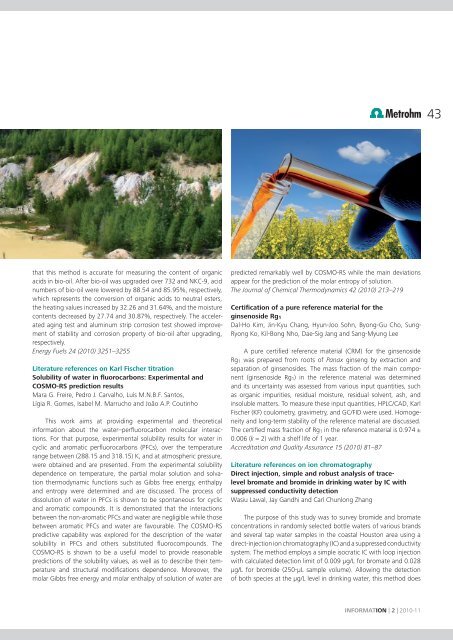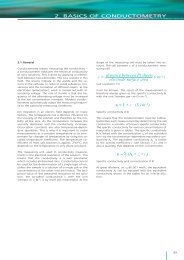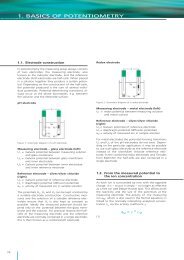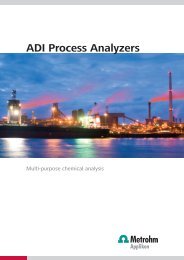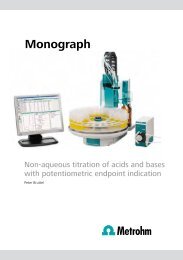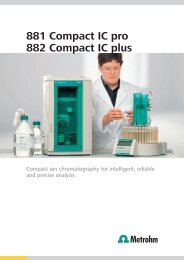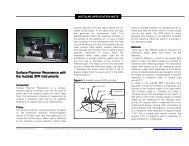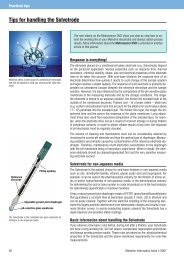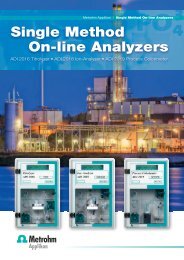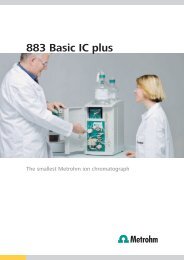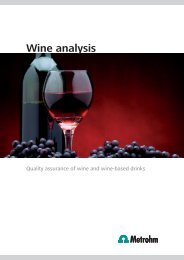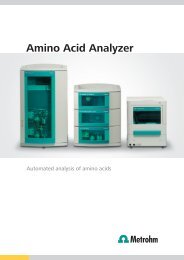Download (PDF) - Metrohm
Download (PDF) - Metrohm
Download (PDF) - Metrohm
You also want an ePaper? Increase the reach of your titles
YUMPU automatically turns print PDFs into web optimized ePapers that Google loves.
43that this method is accurate for measuring the content of organicacids in bio-oil. After bio-oil was upgraded over 732 and NKC-9, acidnumbers of bio-oil were lowered by 88.54 and 85.95%, respectively,which represents the conversion of organic acids to neutral esters,the heating values increased by 32.26 and 31.64%, and the moisturecontents decreased by 27.74 and 30.87%, respectively. The acceleratedaging test and aluminum strip corrosion test showed improvementof stability and corrosion property of bio-oil after upgrading,respectively.Energy Fuels 24 (2010) 3251–3255Literature references on Karl Fischer titrationSolubility of water in fluorocarbons: Experimental andCOSMO-RS prediction resultsMara G. Freire, Pedro J. Carvalho, Luís M.N.B.F. Santos,Lígia R. Gomes, Isabel M. Marrucho and João A.P. CoutinhoThis work aims at providing experimental and theoreticalinformation about the water–perfluorocarbon molecular interactions.For that purpose, experimental solubility results for water incyclic and aromatic perfluorocarbons (PFCs), over the temperaturerange between (288.15 and 318.15) K, and at atmospheric pressure,were obtained and are presented. From the experimental solubilitydependence on temperature, the partial molar solution and solvationthermodynamic functions such as Gibbs free energy, enthalpyand entropy were determined and are discussed. The process ofdisso lution of water in PFCs is shown to be spontaneous for cyclicand aromatic compounds. It is demonstrated that the interactionsbetween the non-aromatic PFCs and water are negligible while thosebetween aromatic PFCs and water are favourable. The COSMO-RSpredictive capability was explored for the description of the watersolubility in PFCs and others substituted fluorocompounds. TheCOSMO-RS is shown to be a useful model to provide reasonablepredictions of the solubility values, as well as to describe their temperatureand structural modifications dependence. Moreover, themolar Gibbs free energy and molar enthalpy of solution of water arepredicted remarkably well by COSMO-RS while the main deviationsappear for the prediction of the molar entropy of solution.The Journal of Chemical Thermodynamics 42 (2010) 213–219Certification of a pure reference material for theginsenoside Rg 1Dal-Ho Kim, Jin-Kyu Chang, Hyun-Joo Sohn, Byong-Gu Cho, Sung-Ryong Ko, Kil-Bong Nho, Dae-Sig Jang and Sang-Myung LeeA pure certified reference material (CRM) for the ginsenosideRg 1 was prepared from roots of Panax ginseng by extraction andseparation of ginsenosides. The mass fraction of the main component(ginsenoside Rg 1) in the reference material was determinedand its uncertainty was assessed from various input quantities, suchas organic impurities, residual moisture, residual solvent, ash, andinsoluble matters. To measure these input quantities, HPLC/CAD, KarlFischer (KF) coulometry, gravimetry, and GC/FID were used. Homogeneityand long-term stability of the reference material are discussed.The certified mass fraction of Rg 1 in the reference material is 0.974 ±0.006 (k = 2) with a shelf life of 1 year.Accreditation and Quality Assurance 15 (2010) 81–87Literature references on ion chromatographyDirect injection, simple and robust analysis of tracelevelbromate and bromide in drinking water by IC withsuppressed conductivity detectionWasiu Lawal, Jay Gandhi and Carl Chunlong ZhangThe purpose of this study was to survey bromide and bromateconcentrations in randomly selected bottle waters of various brandsand several tap water samples in the coastal Houston area using adirect-injection ion chromatography (IC) and a suppressed conductivitysystem. The method employs a simple isocratic IC with loop injectionwith calculated detection limit of 0.009 µg/L for bromate and 0.028µg/L for bromide (250-µL sample volume). Allowing the detectionof both species at the µg/L level in drinking water, this method doesINFORMATION | 2 | 2010-11


